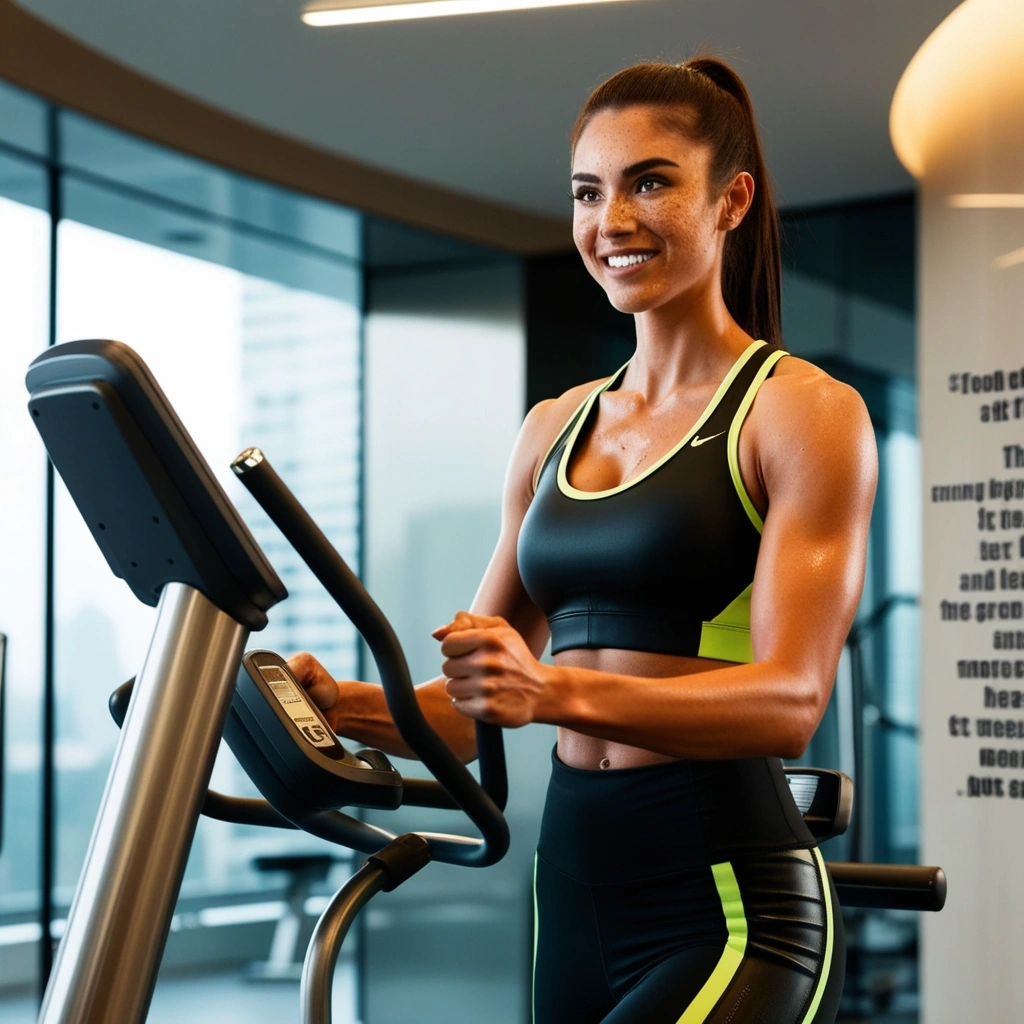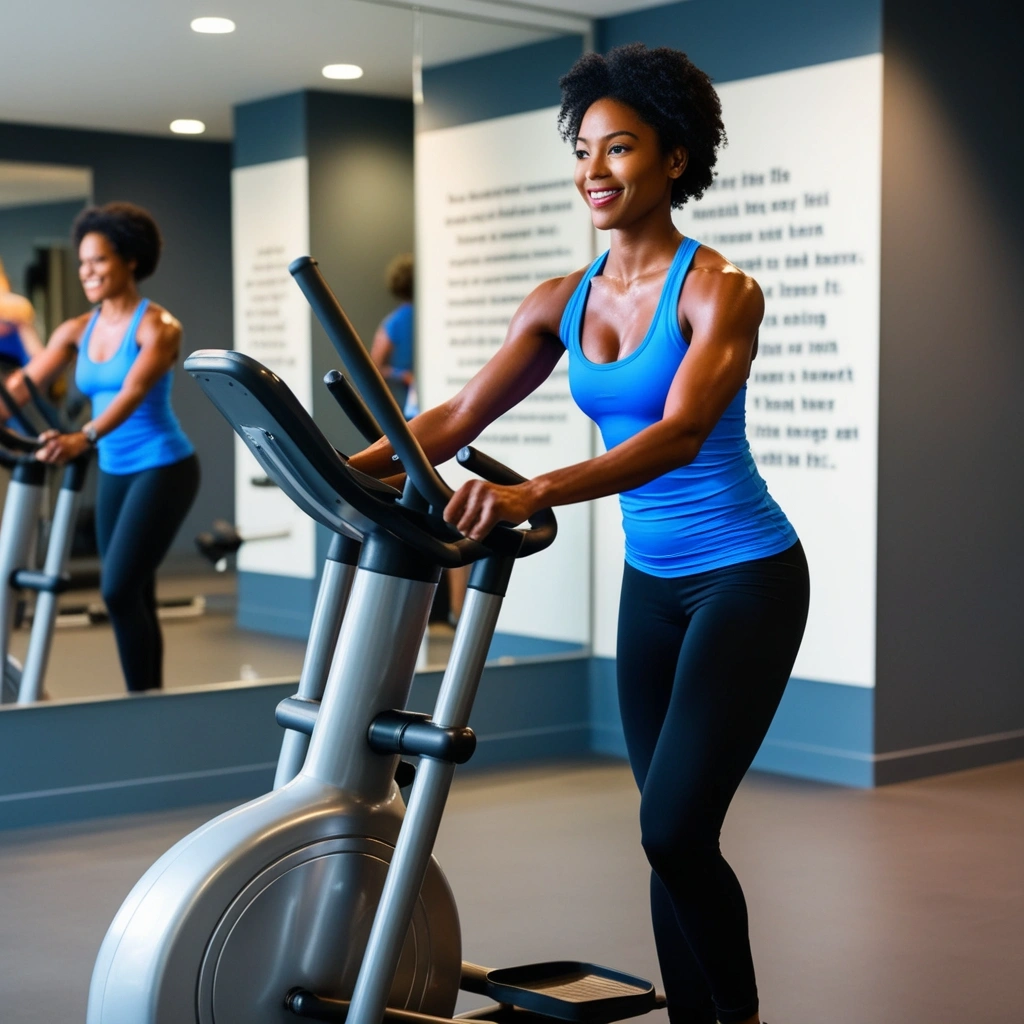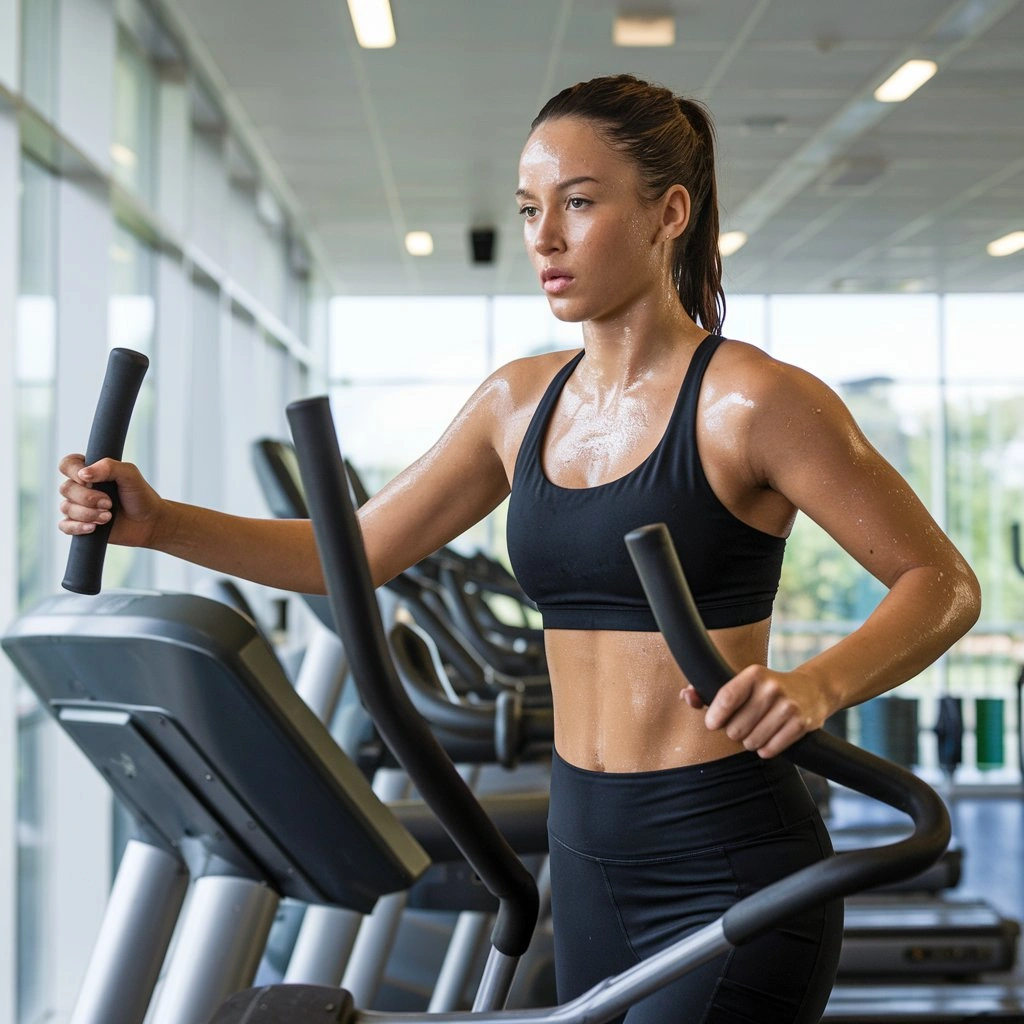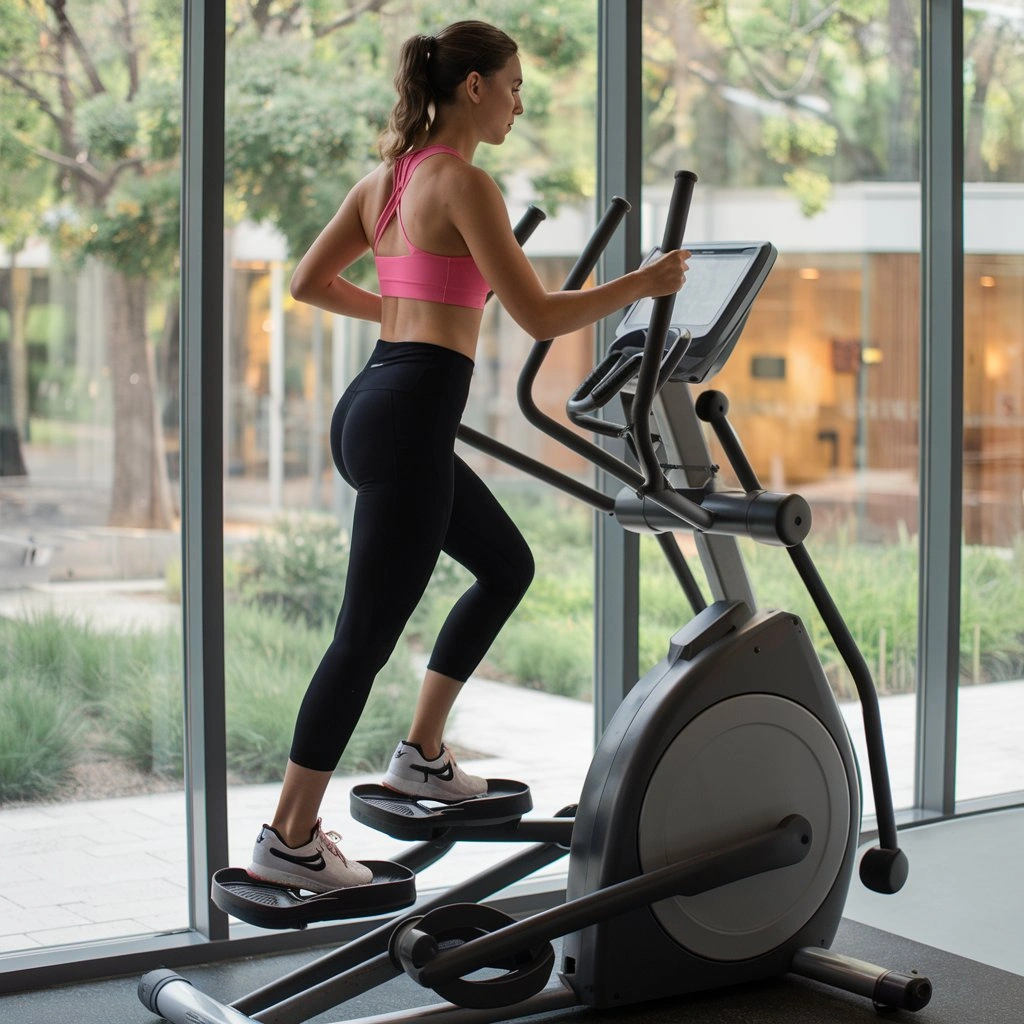Glute Activation on Elliptical is good for low-impact exercise. People who want a toned body wonder if they can build butt muscles on them. Glutes are important muscles, not just for looks, but for moving and sports. Many people who exercise want strong glutes and wonder if ellipticals can help. Elliptical: Does it build glutes?
We’ll dissect the workout, look at science, and talk to real people. Do ellipticals shape your butt? We’ll find out, with science and what others say. New to ellipticals or a pro? This might change your lower-body routine. Let’s ride and see if it builds glutes!
Understanding the Glute Muscles
The gluteal muscles are made of the gluteus maximus, medius, and minimus. They form a strong group in the buttocks. It is crucial to understand their anatomy and function. This is key for evaluating their role in different types of exercise.
- Gluteus Maximus: Big butt muscle – gluteus maximus – helps you run, jump, and climb stairs. It’s the strongest in your glutes.
- Gluteus Medius and Minimus: They are located beneath the gluteus maximus. They are vital for hip stability and abduction. They contribute to maintaining proper alignment of the pelvis and femur during movement. making them vital for balance, posture, and injury prevention. Importance of Strong Glute Muscles for Overall Health and Fitness.
Strong gluteal muscles are more than just for looks. They are key to health and fitness:
- Well-developed glutes boost athletic performance. They provide power, stability, and explosiveness. This helps in actions like sprinting, jumping, and lifting.
- Strong glutes help keep the hips and pelvis aligned. This cuts the risk of injuries like lower back pain, knee pain, and IT band syndrome.
- Improved Posture: Strong glutes help align the pelvis. This promotes good posture and reduces strain on the lower back.
- Functional Movement: Walking, standing up, and bending are everyday activities. They require the use of the glute muscles. Strengthening them enhances mobility and functionality in daily life.
- Functions of the Glute Muscles in Daily Movement and Exercise
The gluteal muscles play multifaceted roles in daily movement and exercise:
- Hip Extension: The main job of the gluteus maximus is hip extension. It is key for activities like walking, running, and climbing stairs.
- The gluteus medius and minimus assist in hip abduction. They move the leg away from the body. They also help with external rotation, the outward rotation of the thigh. They add to stability and proper alignment during movement.
- Stabilization: The gluteal muscles do more than move. They also stabilize and balance. They control the position of the pelvis and femur during activities.
Mechanics of Using an Elliptical Trainer

Elliptical trainers offer a dynamic workout. They engage many muscle groups and provide low-impact cardio. You must understand the mechanics of elliptical training. This is key for evaluating its potential to target and build the gluteal muscles well.
Explanation of How Elliptical Trainers Work
Elliptical trainers simulate walking, jogging, or running. They do this while minimizing the impact on the joints. The basic operation involves:
- Foot Pedals: Users stand on foot pedals that move in an elliptical or oval-shaped path.
- Handlebars provide stability. They can be moved with the foot pedals to work the upper body.
- Resistance Mechanism: Most elliptical trainers have adjustable resistance levels. These levels increase or decrease the workout’s intensity.
Elliptical training is smooth and continuous. It combines elements of cardio and resistance exercise. This makes it an efficient option for full-body workouts.
Elliptical training engages a variety of muscle groups, including:
- Lower Body: Elliptical works quads, hamstrings, calves, and butt muscles. Your butt muscles, especially the big one (gluteus maximus), push the pedals down. They also keep your hips steady.
- Upper Body: The elliptical works your arms and upper body if you use the handlebars. This burns more calories and strengthens your arms, chest, back, and shoulders.
- Comparison of the Range of Motion and Muscle Activation During Elliptical Workouts
Elliptical training offers a unique range of motion and muscle activation. This is unlike other types of cardiovascular exercise.
- Low-Impact Nature: Elliptical is easy on your knees and ankles. This means you can exercise longer without getting too sore. Great for people with joint pain! Full-Body Engagement: The elliptical works your lower body the most. But, you can also use the handlebars to tone your arms and upper body. This burns more calories too.
- Elliptical can build glutes. This is especially true if you go hard and push with your heels. But it depends on your body and how you use it.
Evidence and Research
Ellipticals are great cardio machines, but can they build a strong butt? Science says kind of. It works your glutes more if you push hard and use your heels.
- The studies were scientific. They looked at the effect of elliptical training on glute muscles. They studied both muscle activation and growth.
Studies use fancy machines to see how hard your glutes work on ellipticals. Key findings include:
- Glute Activation: Elliptical gets your glutes working, especially the big butt muscle. One study says it works better than other cardio exercises.
- Variable Activation Patterns: Elliptical works your glutes, but how much depends on you. Push harder and use your heels for a stronger butt workout.
- Individual Variability: Not everyone’s butt works the same on the elliptical. Some people get a better glute workout than others. This means you might need to adjust your workout to target your glutes more.
- We will analyze if elliptical workouts build glutes well. We will compare them to other exercises.
Elliptical works your glutes, but not as much as squats, lunges, or hip thrusts. Those are the best exercises for building a strong butt. But ellipticals are easier on your joints.
- Elliptical training is low-impact. It is an alternative to traditional strength exercises. This makes it good for people with joint issues. It also helps those looking to reduce strain on the lower body.
- Elliptical workouts target the gluteal muscles. They also have cardiovascular benefits. These include improved heart health, endurance, and calorie burn. This approach has two purposes. It can help those who want to improve fitness while sculpting their glutes.
- Complementary Training: Elliptical keeps workouts fresh. It helps other exercises and lets you recover on the move.
- We consider factors such as resistance level, incline, and workout duration. They affect glute activation.
Optimizing glute activation during elliptical training involves strategic adjustments to key variables:
- Resistance Level: Turn up the resistance on the elliptical. It makes your glutes work harder and grow stronger. The harder you push, the more your muscles have to work.
- Incline: Fancy ellipticals let you tilt the machine. It’s like walking uphill, working your butt and legs even more.
- Workout Duration: Long elliptical workouts burn calories and build stamina. But short, hard bursts work your butt just as well. Push yourself for brief periods, rest, and then repeat. This fires up your muscles and helps them grow.
Real-Life Experiences and Testimonials

Science is great, but people like you and me matter too. Let’s hear what others say about building a stronger butt with the elliptical. Elliptical Enthusiasts Share Their Fitness Insights
- Sarah, 32: “As a busy working mom, finding time for exercise can be challenging. I started using the elliptical machine at my local gym. It was a handy way to fit in workouts between work and family. I noticed better heart fitness. I also saw a change in my glutes’ shape and tone.”
- Jake, 45, says: “I got knee pain from running. So, I switched to the elliptical to avoid impact. Initially, I was skeptical about its effectiveness in building muscle. However, after I added elliptical workouts to my routine, I was pleasantly surprised. I gained definition and strength in my glutes. It’s become a staple in my fitness regimen.”
Personal Anecdotes or Success Stories Related to Glute Development Through Elliptical Workouts
- Emily, 28: “I’ve always had weak glutes. They caused lower back pain and workout discomfort. When I started using the elliptical often, I focused on driving through my heels. I also worked on engaging my glutes with each stride. Over time, I noticed significant improvements in both strength and aesthetics. My glutes became firmer and more defined. Also, my lower body strength improved.”
- Alex, 36, says: “I plateaued with my strength training. So, I added more cardio, including elliptical workouts.” Surprisingly, I noticed my glutes becoming more sculpted and shapely within a few weeks. The mix of resistance and endurance training was on the elliptical. It seemed to target my glutes. It did so in a way that traditional exercises hadn’t.”
- C. Consideration of Individual Differences and Variability in Results
Elliptical Training Outcome The Impact of Individual Factors
- Biomechanics: Everyone’s body is different. Long legs, short legs, how you move – all this affects your butt workout on the elliptical.
- Consistency and intensity are key. The more you use the elliptical and the harder you push with good form, the better results you’ll see. Don’t skip workouts and make sure you’re using it right.
- Supplementary Training: Elliptical helps build a butt, but squats and lunges do more. Eat healthy too! Everything works together for the best results.
Expert Opinion and Recommendations
Trainers and doctors know a lot about building a strong butt. Let’s see what they say about using the elliptical the right way.
Insights from Fitness Trainers, Physical Therapists, or Sports Scientists. They are about the Efficacy of Elliptical Training for Glute Development.
- Laura Smith is a Certified Personal Trainer, She says: “Elliptical training can target the gluteal muscles. This is especially true when done with proper form and technique.” Focus on driving through the heels and engaging the glutes. Do this throughout the whole range of motion. It will maximize muscle use and promote growth over time.”
- Dr. David Johnson is a sports scientist, He says: “Studies show that elliptical training can activate the glutes. They do so at moderate to high levels. This is especially true for the elliptical. It’s true at higher resistance levels or with added incline. Adding interval training and varying workout intensity can further challenge the glutes. It can also promote muscle growth.”
Tips for Optimizing Glute Engagement and Muscle Activation During Elliptical Workouts
- Focus on Form. Keep proper posture during the workout. Keep your shoulders back, chest open, and core engaged. Avoid leaning forward excessively, as this can reduce glute activation.
- Push through the heels. Focus on them, not the toes, during each stride. This action helps to engage the gluteal muscles more effectively.
- Increase Resistance Gradually: Gradually raise the resistance on the elliptical machine. This will challenge the glutes and grow muscles over time. Start with a comfortable resistance level and progressively ramp up as strength improves.
- Incorporate Intervals: Go hard, then go easy, repeat! This burns more calories and makes your butt muscles grow stronger.
Alternative Exercises or Complementary Strategies for Targeting the Glutes Effectively
- Strength Training: Squats, lunges, and those hip lifts are your butt’s best friends. Do them with the elliptical for a super butt workout!
- Resistance Band Exercises: Use those stretchy bands for booty exercises too! Walk sideways with the band, open and close your legs like a clam, and lift your hips. These exercises work your butt in different ways and go well with the elliptical.
- Plyometric Exercises: Jumping squats, box jumps, and skater hops are fun and good for your butt! Add them to your workout to mix things up and make your glutes work even harder.

Practical Tips for Maximizing Glute Activation on Elliptical
This is guidance on adjusting stride length, foot position, and posture. It’s for optimal glute activation.
- Stride Length: Focus on a longer stride length to engage your glutes more effectively. A longer stride allows for more motion. It targets the glute muscles more. Be cautious not to overextend your stride. This could strain other muscles or lead to injury.
- Keep your feet firmly on the pedals. Do this for the whole elliptical motion. Ensure that your weight is evenly distributed between the balls of your feet and your heels. Avoid lifting your heels excessively, as this may reduce glute engagement. Experiment with different foot positions. Find the one that feels best while still working your glutes.
- Posture: Maintain proper posture throughout your elliptical workout to maximize glute engagement. Keep your chest lifted, shoulders relaxed, and core engaged. Avoid leaning too far forward or backward, as this can shift the focus away from your glutes. Aim to keep your back straight and aligned with your hips throughout the exercise.
Suggestions for incorporating intervals, and resistance training
- Intervals: Go hard, then go easy, on the elliptical. Sprint or crank up the resistance for short bursts, then recover slower. This burns more calories and works your butt extra hard!
- Resistance Training: Make the elliptical harder to work your butt more. Bump up the resistance as you get stronger. Bands or ankle weights can also give your glutes an extra push.
- Targeted Glute Exercises: Elliptical is great. But, add squats, lunges, and hip lifts. They build a strong butt. Do them regularly to make your glutes work harder and get toned.
Importance of proper form and technique to prevent injury and maximize results
- Proper Form: Use the elliptical right to avoid getting hurt and get the most out of it. Stand tall, keep your core tight, and move smoothly. Don’t swing around – that can hurt you!
- Technique: Pay attention to your technique and biomechanics while using the elliptical machine. Make sure you’re pushing through your heels. Also, engage your glutes with each stride. Avoid locking your knees or over-straightening your joints. This can stress the muscles and joints.
- Gradual Progression: Don’t overdo it! Start slow and easy, then go harder, longer, and with more resistance as you get stronger. Pay attention to your body – if it hurts, take a break. Slow and steady wins the race, especially when it comes to avoiding injuries.
Conclusion
Summary of key points discussed in the article
- Adjust your stride length. Keep your feet in the right spot. Also, mind your posture. These things can boost glute activation during elliptical workouts.
- Supercharge Your Glute Strength: Elliptical Training with Intervals, Resistance, and Targeted Exercises
- The article emphasized the importance of proper form and technique. These are key to prevent injury and get the best results.
Elliptical builds a strong butt, but you gotta do it right. Focus on your glutes, how you step, and your posture. Push yourself in bursts, add resistance, and do exercises that target your butt too. This all works together to get the results you want.
Finally, some thoughts on the benefits of adding elliptical training to a full fitness plan. It’s good for lower body strength and conditioning.
The elliptical is a great way to strengthen your lower body without pounding your joints. It works your butt, thighs, and calves all at once.
You can make it target your butt even more by using the right form and doing extra exercises. The elliptical is easy to adjust for different fitness levels, so anyone can use it to get stronger.
Additional Resources and References
List of relevant studies, articles, and resources for further reading:
- Schoenfeld, B. J., Contreras, B., Tiryaki-Sonmez, G., Willardson, J. M., & Fontana, F. (2014). We compared two planks using electromyography. One was a modified plank with a long lever and posterior tilt. The other was the traditional plank. Sports Biomechanics, 13(3), 296-306.
- Willardson, J. M. (2007). Core stability training: applications to sports conditioning programs. Journal of Strength and Conditioning Research, 21(3), 979-985.
- American Council on Exercise (ACE). (n.d.). Glute Activation: 6 Exercises to Fire Up Your Glutes Before Training. Retrieved from https://www.acefitness.org/education-and-resources/lifestyle/blog/5077/glute-activation-6-exercises-to-fire-up-your-glutes-before-training/
B. Links to trusted fitness websites, forums, or communities. These are for more discussion and support.
- Bodybuilding.com Forums: “FitConnect: Your Community Hub for Fitness Enthusiasts. Website: https://forum.bodybuilding.com/
- Reddit Fitness Community:
An active subreddit dedicated to fitness discussions, including workout tips, and progress updates. Website: https://www.reddit.com/r/Fitness/ - ACE Fitness Blog:
The American Council on Exercise offers a lot of fitness and health info. It does this through its blog. Website: https://www.acefitness.org/education-and-resources/lifestyle/blog

